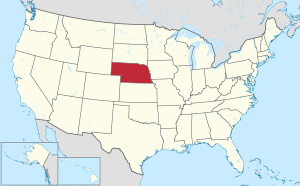|
Boone County, Nebraska
Boone County is a county in the U.S. state of Nebraska. As of the 2020 United States Census, the population was 5,386.[1] Its county seat is Albion.[2] The county was organized in 1871[3] and named after Daniel Boone.[4] In the Nebraska license plate system, Boone County is represented by the prefix 23 (it had the 23rd-largest number of vehicles registered in the county when the license plate system was established in 1922). GeographyAccording to the US Census Bureau, the county has an area of 687 square miles (1,780 km2), of which 687 square miles (1,780 km2) is land and 0.7 square miles (1.8 km2) (0.1%) is water.[5] Major highwaysAdjacent counties
HistoryBoone County, Nebraska, was created on March 1, 1871, and named in honor of frontiersman Daniel Boone. The settlement of Boone County began with the arrival of explorers and settlers in the late 1860s. One of the first white settlers was S.D. Avery, who in 1871 established a claim near what would become the town of Albion. The initial settlement was encouraged by the expansion of railroads and the availability of land under the Homestead Act of 1862.[6] The community of Albion was platted in 1872 and became the county seat after a contest with the town of Boone. This rivalry for the county seat was common in many frontier counties, reflecting the ambition and growth aspirations of the nascent communities. Agriculture quickly became the backbone of the local economy, with wheat, corn, and later oats being predominant.[6] The development of Boone County was relatively rapid thanks to its fertile soil and the dedication of its settlers. The railroad, reaching Albion in the early 1880s, played a crucial role in the county's growth, providing access to markets for agricultural products and bringing in more settlers. The county's population and infrastructure expanded, with schools, churches, and businesses being established to support the burgeoning agricultural community.[6] Demographics
As of the 2000 United States Census,[11] there were 6,259 people, 2,454 households, and 1,700 families in the county. The population density was 9 people per square mile (3.5 people/km2). There were 2,733 housing units at an average density of 4 units per square mile (1.5/km2). The racial makeup of the county was 99.25% White, 0.05% Black or African American, 0.05% Native American, 0.03% Asian, 0.03% Pacific Islander, 0.30% from other races, and 0.29% from two or more races. 0.89% of the population were Hispanic or Latino of any race. 54.6% were of German, 8.2% Irish, 5.9% Polish, 5.3% Norwegian and 5.1% Swedish ancestry according to Census 2000. There were 2,454 households, out of which 33.90% had children under the age of 18 living with them, 60.80% were married couples living together, 5.50% had a female householder with no husband present, and 30.70% were non-families. 29.10% of all households were made up of individuals, and 16.50% had someone living alone who was 65 years of age or older. The average household size was 2.50 and the average family size was 3.11. 29.10% of the population is under the age of 18, 5.00% from 18 to 24, 24.20% from 25 to 44, 21.40% from 45 to 64, and 20.40% who were 65 years of age or older. The median age was 40 years. For every 100 females there were 99.10 males. For every 100 females age 18 and over, there were 96.40 males. The median income for a household in the county was $31,444, and the median income for a family was $38,226. Males had a median income of $26,779 versus $18,438 for females. The per capita income for the county was $15,831. About 8.30% of families and 10.40% of the population were below the poverty line, including 11.70% of those under age 18 and 11.60% of those age 65 or over. CommunitiesCities
VillagesCensus-designated placesUnincorporated communityPoliticsBoone County voters have been strongly Republican for decades. In only one national election since 1936 has the county selected the Democratic Party candidate.
See alsoReferences
External linksWikimedia Commons has media related to Boone County, Nebraska.
|
|||||||||||||||||||||||||||||||||||||||||||||||||||||||||||||||||||||||||||||||||||||||||||||||||||||||||||||||||||||||||||||||||||||||||||||||||||||||||||||||||||||||||||||||||||||||||||||||||||||||||||||||||||||||||||||||||||||||||||||||||||||||||||||||||||||||||||||||||||||||||||||||||||||||||||||||||||||||||||||||||||||||||||||||||||||||||||||||||||



